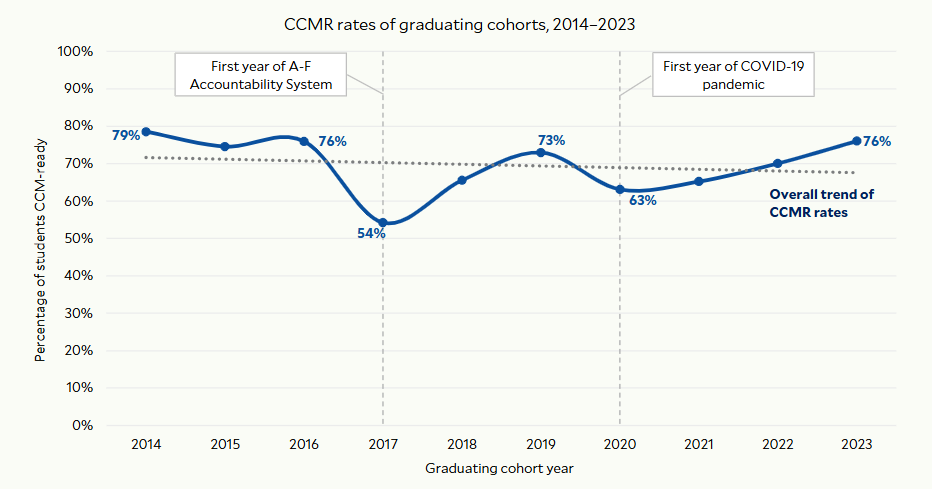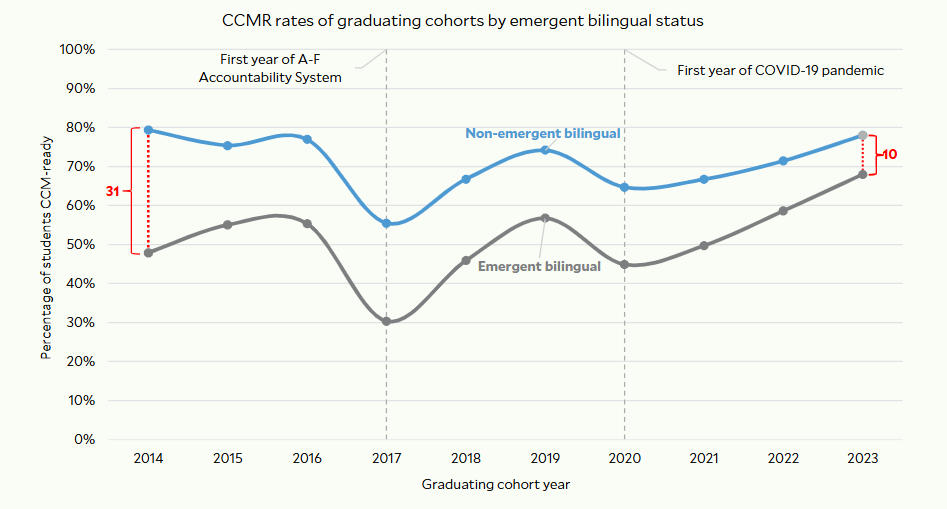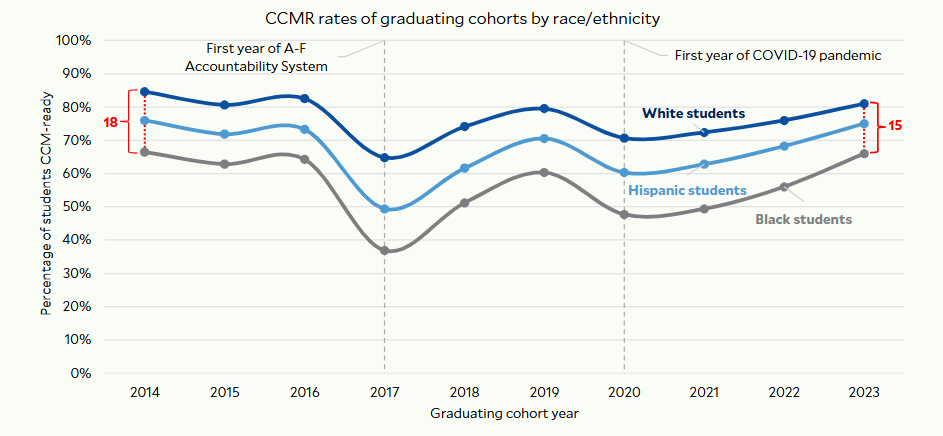By Gabriela Sánchez-Soto and Mauricio Molina
Sánchez-Soto and Molina are researchers for the Kinder Institute's Houston Education Research Consortium.
Every five years, state education leaders change how Texas grades public schools and districts. It’s a somewhat arcane process, but these decisions have an enormous impact on Texas students. Schools partially decide what to prioritize, how to allocate resources, what classes to offer and what programs to provide based on the accountability framework.
One major component of this grading system is a standard known as “college, career and military readiness,” or CCMR. Districts and schools earn a better grade when more graduates meet one of 11 targets, such as scoring well on college entrance exams, earning career-oriented certifications or enlisting in the military. CCMR performance can be the difference between a spectacular or substandard overall accountability rating, and the state delivers more money to schools with strong CCMR results.
Given the importance of CCMR to Texas schools, our team at the Kinder Institute’s Houston Education Research Consortium has spent the past year evaluating the state’s approach as part of EduDream’s national effort to explore improvements to K-12 accountability systems. We reviewed state laws that outline system requirements, documents detailing discussions between Texas Education Agency leaders and advisers responsible for establishing the system, and statewide CCMR data over the past decade.
State leaders aimed to develop policies that were transparent, rigorous and well-understood by the public. Ultimately, officials succeeded in creating multiple new pathways to postsecondary readiness, better reflecting the diverse needs of Texas’ students and economy.
But the process of crafting the standards was strained at times by a disconnect between state officials and community representatives providing recommendations. Districts and high schools also struggled to keep up with shifting CCMR targets set by the state. What’s more, they made little progress in closing some persistent readiness gaps between students from different racial, ethnic and economic backgrounds.
Our research highlighted opportunities for improving communication, transparency and trust that are relevant to state and local workforce needs. These are four of our biggest takeaways from our review, along with our recommendations as the state looks ahead to its next system update in 2028.
Texas’ accountability system keeps changing, sometimes faster than schools can react
The state’s accountability framework is supposed to stay the same for five consecutive years, but there’s wiggle room for the TEA to add, subtract and change CCMR measures in the meantime. At multiple points over the past decade, TEA leaders tweaked several CCMR metrics, such as adding more industry-based certifications that qualify for credit.
However, districts and schools struggled to keep up with the continuous change. Many local educators couldn’t or didn’t implement new approaches fast enough to get CCMR credit, an issue exacerbated by the COVID-19 pandemic.

Some members of the TEA’s advisory committees — which included local educators, parents, business leaders and legislative staffers — expressed concern about the constant adjustments as early as 2017 and argued for a longer phase-in period.
Establishing a more stable, responsive timeline for major CCMR updates would give districts the necessary time to adapt and create a fairer system across the state.
Communication and alignment faltered between the TEA and advisory groups
Under state law, three groups have a role in developing the accountability framework. Lawmakers establish broad outlines of the system, then the TEA develops the details while considering the recommendations and feedback from its community advisory committees.
While the TEA and advisory committees are meant to work in tandem during the development phase, documents show a recurring disconnect. For example, advisory group members said in 2018, just before a refreshed system took effect, that they felt the TEA was “not considering the committee’s recommendations” and “unresponsive” to the group’s concerns. In 2021, when one committee wanted to revisit a TEA recommendation that members hadn’t debated, state officials said it was “not under discussion.”
The apparent communication and coordination issues undercut the policymaking process, making it hard for some voices to be heard and for school districts to adapt to changes.
A more formalized TEA decision-making process that includes improved communication with advisory committees would ensure that important voices are not left out of the discussion and bolster transparency.
Students’ readiness rates fell, then recovered following disruptions
After the TEA implemented the biggest overhaul of its CCMR framework in 2017-18, the state’s readiness rates plummeted from 76% to 54% in a single year. At the time, changes were not phased in to allow school districts to adapt to the new guidelines.
CCMR rates quickly rebounded within two years, dipped again due to the pandemic, then rose to 76% for the Class of 2023.
Some of the improvements likely reflect district leaders adjusting their strategies to ensure more graduates get credit for CCMR. Some might be related to innovative initiatives to enhance access to college and career pathways, supported by legislative action. Some might be the result of how Texas counted readiness.
System changes produced mixed results by student demographic
In the years following the 2017-18 overhaul, some student groups made big gains in CCMR relative to state averages, while other performance gaps held steady.
Much of the improvements likely stem from state officials expanding the definition of CCMR, though some might be the result of increased attention on those students.
For example, the gap in CCMR rates between students receiving special education services and the state average went from 31 percentage points in 2014 to 7 percentage points in 2023. Starting in 2018-19, students receiving special education services could earn CCMR credit if they graduated under an advanced degree plan.

The state saw a similar improvement for emergent bilingual students, though it’s difficult to tell from available data what caused the rise.
Other preexisting disparities, however, remained virtually unchanged. The state saw minimal or no improvement in CCMR rate gaps for Black, Hispanic or economically disadvantaged students when compared to state averages.

To reproduce the level of CCMR success with students receiving special education services and emergent bilingual students, policymakers need to establish similar targeted programs for students who need it the most. Bridging gaps in postsecondary readiness is a powerful tool for enabling students to succeed in early adulthood.


